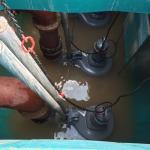Optimising Flow Rates in GRP Pumping Stations
GRP pumping stations are often chosen for a wide variety of non-adoptable applications, such as irrigation, attenuation and flood protection. These crucial systems can be installed to prevent damage to property
GRP pumping stations are often chosen for a wide variety of non-adoptable applications, such as irrigation, attenuation and flood protection. These crucial systems can be installed to prevent damage to property, rail networks and roadways so the efficiency and flow rate of the system needs to be carefully considered.
For example, the efficiency of the system can be significantly impacted if an inadequate flow rate is maintained over time. This is because the pressure, elevation and pipe size must all be taken into account when designing an efficient GRP pumping station system.
In addition to these factors, environmental conditions also play a role in affecting the performance of these systems. Consequently, it is important to ensure that these factors are considered when constructing or upgrading existing facilities to ensure optimal results.
The main challenge with optimising flow rates at GRP pumping stations lies in determining the best combination between infrastructure elements and environmental conditions to achieve maximum efficiency without compromising on safety or other considerations such as cost savings.
Factors Affecting Flow Rates
To properly consider the factors that affect flow rates, it is essential to have an understanding of how they interact with each other. For instance, elevation has a direct impact on the head loss and pressure within a system, while pipe size determines the maximum capacity for a given flow rate. Additionally, environmental conditions such as temperature can also influence flow rates due to changes in water viscosity or air pressure.
As such, it is important to ensure that these parameters are taken into account when designing or upgrading GRP pumping stations to maximise efficiency without compromising safety.
Moreover, one should also pay attention to the type of material used for piping to ensure optimal performance from GRP pumping stations. This is because different materials exhibit varying levels of resistance against wear and tear caused by corrosive elements that are present in water and sewage systems; thus making them more suitable for specific applications than others. In addition, some materials may be better suited for certain environments due to their chemical composition; this could potentially save money over time by reducing maintenance costs associated with replacing damaged pipes and pumps frequently.
Finally, cost savings should always be kept in mind when planning upgrades or constructing new facilities since this will help determine if investing in expensive infrastructure elements is ultimately worth it in terms of improved performance results over time. Therefore, careful analysis should be conducted before any decisions are made regarding investments related to GRP pumping stations so as not only to maximise efficiency but also to minimise unnecessary expenses where possible.
Conclusion
There is more that goes into maintaining an efficient flow rate in your GRP pumping station than you might initially think and it is essential for a variety of applications and should not be overlooked.
It is important to consider various infrastructure elements, environmental conditions, and cost savings when designing or upgrading existing facilities to maximise efficiency without compromising safety. Furthermore, the type of material used for piping can also play an important role in ensuring optimal performance from these systems.
Our expert team consider all these factors and will help ensure that your investment in a GRP pumping station offers efficient flow rates for your specific circumstances and the challenges that your site might offer.




